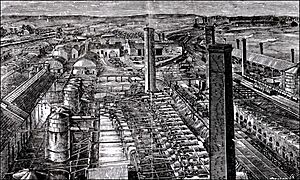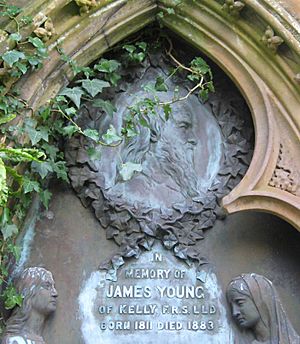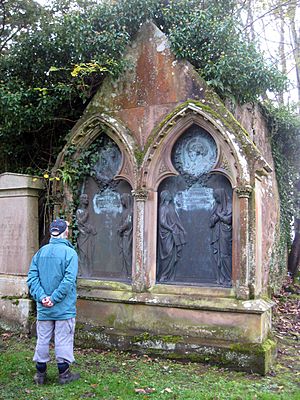James Young (chemist) facts for kids
Quick facts for kids
James Young
|
|
|---|---|
 |
|
| Born | 13 July 1811 Glasgow, Scotland
|
| Died | 13 May 1883 (aged 71) Wemyss Bay, Scotland
|
| Nationality | Scottish |
James Young (born July 13, 1811 – died May 13, 1883) was a Scottish chemist. He is famous for finding a way to get paraffin oil from coal and oil shale. People often called him Paraffin Young because of this.
Contents
Early Life and Education
James Young was born in Glasgow, Scotland. His father was a cabinetmaker. James started working as his father's helper when he was young. But he also taught himself by going to night school.
When he was 19, he started taking evening classes in Chemistry at Anderson's College. This college is now called Strathclyde University. There, he met Thomas Graham, a chemistry teacher. In 1831, Young became Graham's helper. He even taught some of Graham's classes sometimes.
At Anderson's College, Young also became friends with the famous explorer David Livingstone. Their friendship lasted until Livingstone's death many years later. On August 21, 1838, James married Mary Young. They moved to Lancashire, England, in 1839.
A Career in Chemistry
Young wrote his first science paper in 1837. It was about making a voltaic battery better. A voltaic battery is a device that makes electricity. Later that year, he moved to University College London. He helped Thomas Graham with his experiments there.
Working with Chemicals
In 1839, Young became a manager at a chemical factory. It was near St Helens, Merseyside. In 1844, he moved to another company in Manchester. There, he found a way to make sodium stannate directly from a mineral called cassiterite.
Helping with Potato Blight
In 1845, Young joined a group studying potato blight. This was a plant disease that ruined potato crops. He suggested putting potatoes in a weak sulphuric acid solution. He thought this might help fight the disease.
He also helped start a newspaper called the Manchester Examiner. It was first printed in 1846.
Discovering Oils
In 1847, Young learned about a natural oil leak in a coal mine. This was in Alfreton, England. He took this crude oil and heated it. He got a light oil that could be used in lamps. He also got a thicker oil that was good for oiling machines.
In 1848, Young started a small business with his friend Edward Meldrum. They cleaned and processed this crude oil. Their new oils worked well. But the oil from the mine soon ran out in 1851.
Young noticed the oil was dripping from the mine's sandstone roof. He thought that heat acting on the coal might create the oil. He decided to try to make oil artificially.
He did many experiments. Finally, he found a way to make a liquid like petroleum. He did this by heating a type of coal called cannel coal at a low temperature. Young found that slow heating could give him many useful liquids. One of these he called "paraffine oil." It was named this because it turned into a substance like paraffin wax when it got cold.
Getting Patents
Young got a patent for making these oils and solid paraffin wax from coal. This was on October 17, 1850. A patent is a special right that stops others from copying an invention.
In 1850, Young and his partners started a company. Their factory was built in Bathgate, Scotland, in 1851. This was the world's first real commercial oil factory. They used oil from local rocks like torbanite and coal. They made naphtha and oils for machines. They started selling paraffin for fuel and solid paraffin in 1856.
In 1852, Young moved back to Scotland. That same year, he got a US patent for making paraffin oil from coal. His patents were protected in both countries. Other companies had to pay him money to use his methods.
Torbanite was a very rich rock. It gave 537 liters of oil per tonne. But it was a limited resource and ran out by 1862. Later, oil shales were found nearby in 1858. These shales gave less oil, about 150-180 liters per tonne. But this discovery meant Young could keep his business going.
Young's Paraffin Light and Mineral Oil Company

In 1865, Young bought out his business partners. He built a second, much larger factory at Addiewell, Scotland. This was a huge industrial site. It was one of Scotland's biggest chemical factories at the time. In 1866, Young sold the business to Young's Paraffin Light and Mineral Oil Company.
Young stayed with the company but did not work actively. He spent his time sailing, traveling, and doing scientific studies. He also looked after the land he had bought.
The company kept growing. It sold paraffin oil and paraffin lamps all over the world. This is how James Young got his nickname, "Paraffin" Young. The Addiewell factory was the main center for the company. By the 1900s, almost 2 million tons of shale were dug up each year. About 4,000 men worked in the industry.
The oil shale industry in Scotland was at its busiest around 1892. But it started to decline. Heating the oil shale was expensive and used a lot of energy. Cheaper oil from Russia and the USA made it hard for the oil shale industry to compete. The industry almost disappeared by 1919, long after Young had died. Young's refinery closed around 1921.
Other Important Work
- Young started a volunteer army group in Bathgate in 1862. It was mostly made up of workers from his chemical factory. He was the leader until 1865.
- In 1872, Young made important discoveries about how to stop ships from rusting. He noticed that water in the bottom of ships was acidic. He suggested using quicklime to stop it from corroding iron ships. The Royal Navy later used his ideas.
- Around 1880, Young worked with Professor George Forbes. They studied the speed of light. They used a better version of a method invented by Hippolyte Fizeau.
Awards and Recognition
- In 1847, Young became a member of the Manchester Literary and Philosophical Society.
- In 1861, he was chosen as a Fellow of the Royal Society of Edinburgh.
- From 1868 to 1877, he was the President of Anderson's College. He also started a special chemistry teaching position there, called the Young Chair of Technical Chemistry.
- In 1873, Young was chosen as a Fellow of the Royal Society.
- In 1879, he received an honorary degree (LLD) from St. Andrews University.
- From 1879 to 1881, he was the Vice-President of the Chemical Society.
Legacy
James Young helped pay for statues of his old teacher, Thomas Graham, and his friend, David Livingstone. These statues are in Glasgow.
From 1855, James 'Paraffin' Young lived at Limefield House. A sycamore tree that Livingstone planted in 1864 still grows there. You can also see a small version of the "Victoria Falls" at Limefield House. Young built it as a tribute to Livingstone.
Young was a lifelong friend of David Livingstone. He gave a lot of money to help Livingstone's trips to Africa. He also helped pay for a search party when Livingstone went missing. Young also paid for Livingstone's helpers to come to England. He gave a statue of Livingstone to Glasgow.
Many places are named after him. These include the James Young High School in Livingston. Also, James Young Road in Bathgate and the James Young Halls at the University of Strathclyde are named for him.
In 2011, he was one of the first people to be put into the Scottish Engineering Hall of Fame.
See also
- Pumpherston
- Luther Atwood
- Abraham Pineo Gesner
- Alexander Selligue
- History of the oil shale industry
- Monkland Railways
- Wilsontown, Morningside and Coltness Railway




